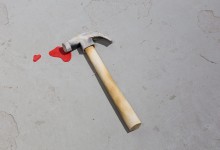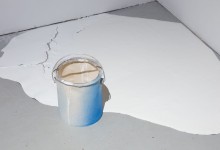Opening reception: Saturday, November 3, 2018 from 3-5 p.m.
Finissage: Thursday, December 20, 5 – 7 p.m.
Éric Lamontagne: Wink
Art Mûr, Montreal, QC
Curator : Louis Déry
Translated by Rosalie Tellier
Lie, lie, and something of the truth will always remain.
— Assigned to Voltaire
If you tell a big enough lie and tell it frequently enough, it will be believed.
— Adolf Hitler
We don’t ask from art to be true, but to be authentic.
— Pierre Laroche
It is throughout Pierre Laroche’s exhibition: Where Are We Heading? A Quick Review that we discover Éric Lamontagne’s exhibition Wink constituted of two paintings and numerous painted objects that punctuate the visitor’s journey. As an occasional optical illusionist artist and Cabanist1, Lamontagne infiltrates the retrospective exhibition and places artworks that allude at once to a street space and to a gallery amidst installation (measuring tape, manhole cover, tools, orange cones, puddles, etc.). To these, he adds two lacerated landscape paintings that reveal nature’s fragility.
Lamontagne has an interest for the conflicting relationship that exists between the end of the landscape and its contemplation, as well as for the so-called death of painting. The parallel between landscape’s decay and painting’s obsolescence nurtured his artistic process. The artist decided to cut right through his landscape paintings and to reuse the cutout pieces from the same canvas into 3D consumer goods. These canvas deductions partially disfigure the painted sceneries. His gesture toward trompe-l’oeil is somewhat reminiscent of the cubist technic of painting objects on multiple angles at once, allowing them to emerge from the surface of the canvas. Here, illusion becomes disillusion.
The painted objects are also dispersed in the gallery space in an intentional disorder. The artist aims to create a bridge with Laroche’s works. For example, he puts a taxidermied crow perched on a step ladder, positioning it as if it was observing the painting Détour, in which a black bird flies above contradictory road panels. Through this visual dialogue and this narrative set up, Lamontagne offers a mise-en-abîme: an exhibition within an exhibition.
The connection between an exterior space under construction and an interior space in installation offers a poetic parallel to a future state of the world. For Lamontagne, this is redemption through art: “Traffic accessories and tools, once metamorphosed into artworks, become a canvas that unfolds before of us.”
1. The Cabanist movement is defined by curator and art historian M-F Beaupré: Socially-engaged artists, the Cabanists produced works in style that included Conceptual Art and Land Art, evoked popular imagery, and experimented with new ways of representing landscapes. Their works raised questions about identity and appropriation of territory in both Quebec and Canada. (Excerpt from the booklet Cabanism A New Perspective on a Little-Known Art Movement, Rivière-du-Loup, Bas-Saint-Laurent Museum Edition, Contemporary Art Series, 2011, tri-fold booklet)


















